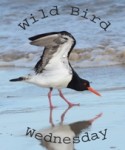On garbage days, the birds usually get there before the collectors. Invariably, one or more of our neighbors will put some of their wet garbage into a flimsy plastic supermarket bag, making it easy for the Muscovy Ducks, Boat-tailed Grackles and White Ibis to scatter the contents in their search for nutritious morsels. We don’t have House Sparrows, and rarely see European Starlings, so common and often reviled in many urban areas. So, for “trash birds,” we have to settle for the alien Muscovies and the native grackles and ibis. This one was walking on our front lawn yesterday morning:


The introduced and rapidly growing populations in southern Europe are seen as a potential problem, since these large predators can devastate breeding colonies of
species such as terns. They also compete successfully for nest sites with Cattle and Little Egrets. The adaptable Ibises supplement their diet by feeding at rubbish tips, which helps them to survive the winter in these temperate regions. (Wikipedia).
I found this Sacred Ibis image on Flickr.com:
Florida, home to thousands of species of introduced plants and animals, has now been invaded by the Sacred Ibis.
PALM BEACH, Fla., Nov. 14 Palm Beach County said it is joining Florida and federal officials to eradicate the sacred ibis, an exotic African bird seen as a threat to local species.
The sacred ibis — an ancient revered by the Egyptians and depicted in hieroglyphics on their pyramids — has begun nesting in western Palm Beach County preserves and the Everglades National Park. Researchers said they fear that if the birds multiply unfettered, they’ll threaten native species such as the white ibis and the federally endangered wood stork, The South Florida Sun-Sentinel reported Wednesday.
County commissioners voted to join the cooperative effort to remove the birds from South Florida, killing them with gunshots if necessary, despite objections from some local environmentalists, the Fort Lauderdale newspaper reported.
Audubon of Florida, in a letter supporting the eradication effort, said the fear is the sacred ibis, if left unchecked, could devastate the populations of other wading birds by preying on chicks and eggs.
Activist Rosa Durando said it has not been documented that the sacred ibis poses a threat to local birds. She said development posed a greater threat.
She said killing the birds would be similar to “handling a flea with an atom bomb.” (Copyright 2007 by UPI)
Many Florida birders seek to observe another handsome alien bird that has increased in recent years. Until this summer, I have regularly seen them near our Miramar home and in the neighboring city of Pembroke Pines, as well as in the Everglades. The robust Purple Swamphen looks like a “Purple Gallinule on steroids.” At first I was thrilled to see one, but then learned of the threat they pose to our native birds, and possibly to crops.
Not so sacred, the Purple Swamphens are now much harder to see. Their population was estimated to be about 200 in 2003, increasing to over 1000 by 2006. It is ironic that a bird that adapted so readily in the wilds of Florida is not considered “established” (and thus is not “countable” under the rules of the birding game). In testimony before the US House of Representatives, the American Bird Conservancy expressed the fear that it may become “established.” This has now led to a dramatic extermination program. The South Florida Sun-Sentinel reported in September 2007 (excerpted from this Web site):“In one of the quickest and most explosive eradication programs ever aimed at an exotic species in South Florida, state officials have gunned down more than 800 swamphens in the past 18 months, determined to wipe out a bird that has been rapidly spreading through wetlands in Broward, Palm Beach and Hendry counties.
“In a coordinated, tri-county assault one day last week, shooters with the Conservation Commission, the South Florida Water Management District and the U.S. Fish and Wildlife Service killed more than 200 swamphens, including 172 in the marshlands of western Palm Beach County.
“The high numbers surprised commission exotic species coordinator Scott Hardin, who upped his estimate of surviving swamphens from 200 to at least 500. And they are now nesting.”
‘We want to be optimistic and realistic,’ said Hardin. ‘But getting rid of things is tough.’















December 3rd, 2007 at 4:53 pm It seems to me like an unusually large amount of time and resources is being devoted to the eradication of these two species. While I agree that they could pose a threat to native birds, I think more resources should be allocated toward KNOWN threats to native birds, such as feral cats, widespread pesticide use, cell towers, and habitat destruction. But these are much harder to tackle than simply taking aim and pulling the trigger.